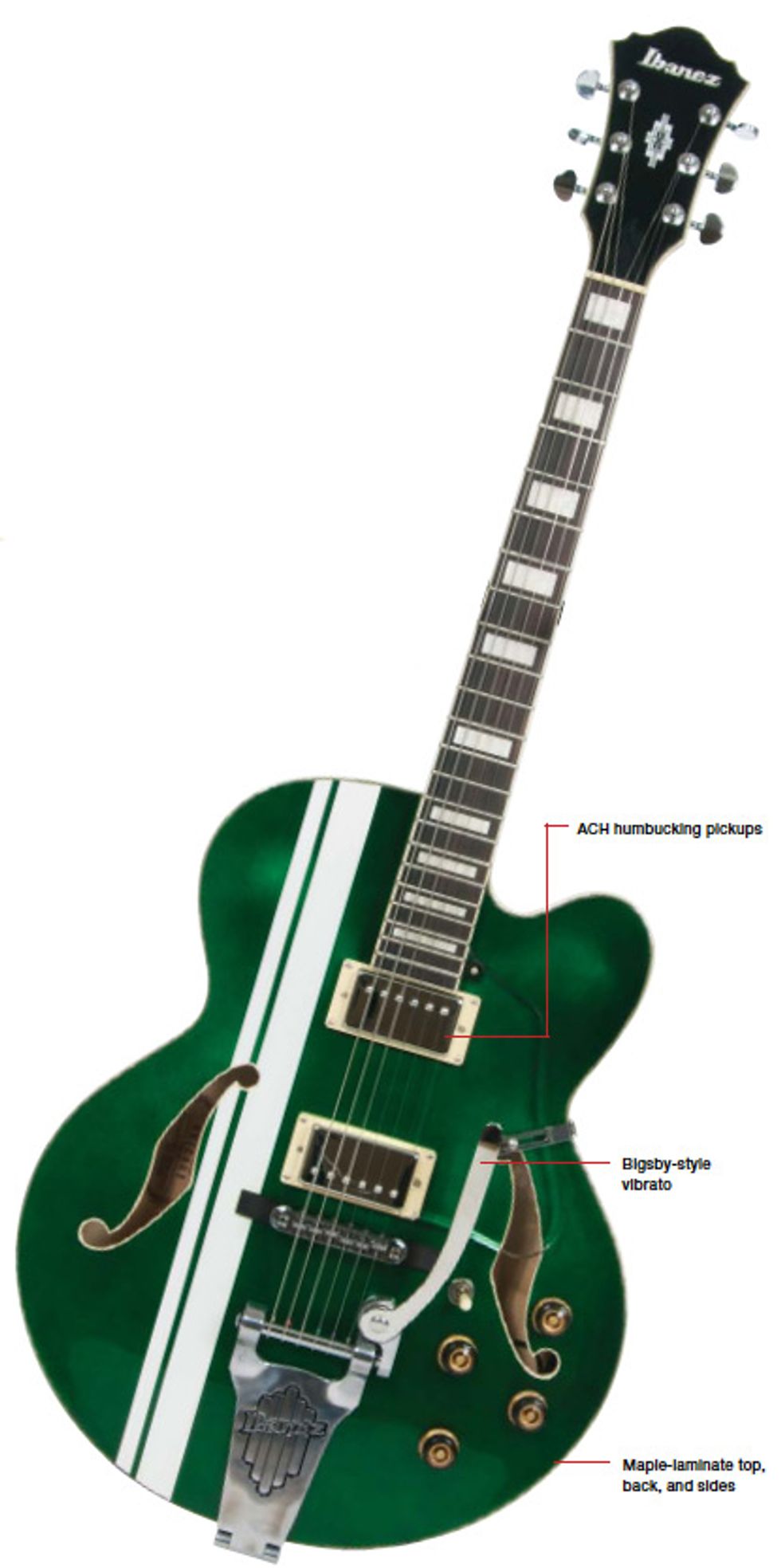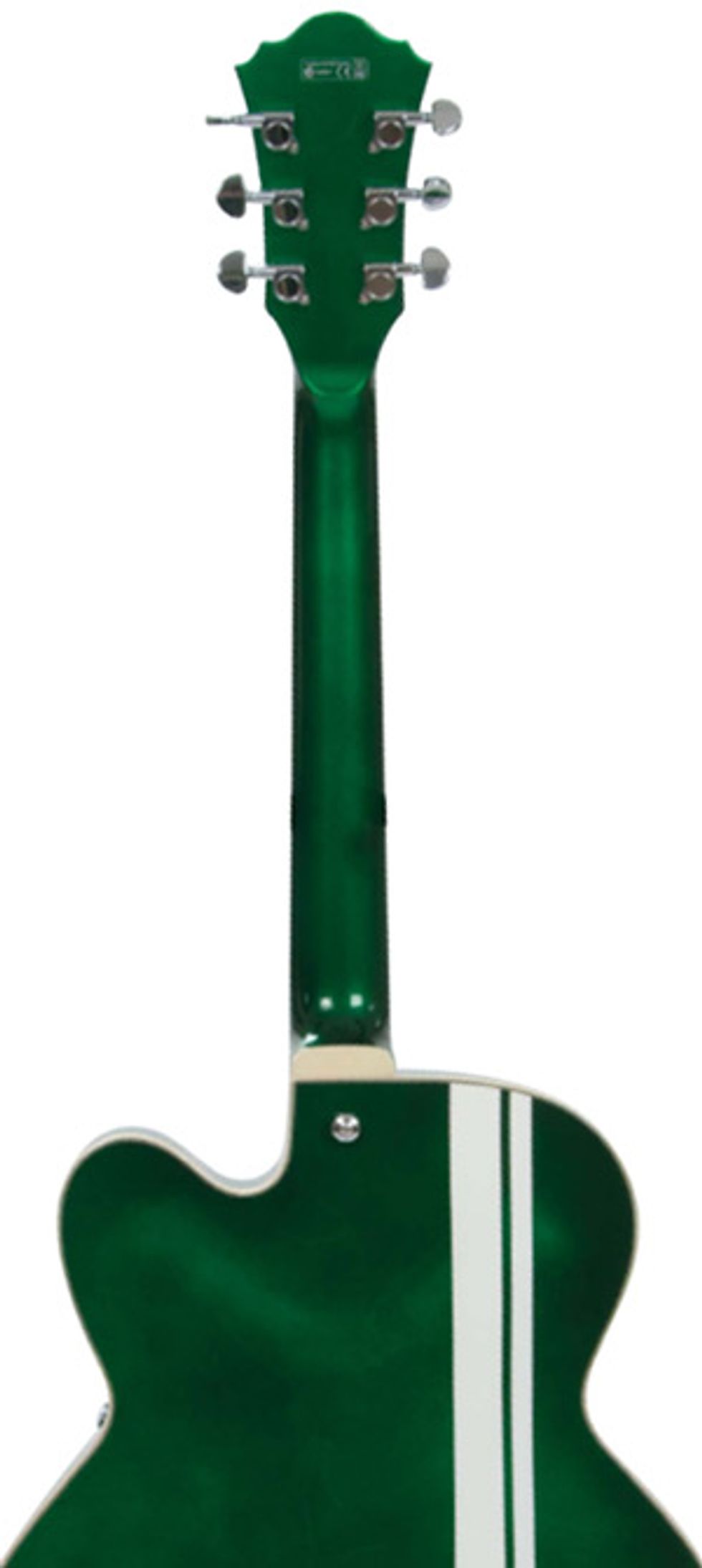A fully hollow, single-cutaway thinline with twin humbucking pickups and a Bigsby-type tailpiece
 | |
| Download Example 1 Bridge pickup with Boss OD-3 | |
| Download Example 2 Both Pickups | |
| Download Example 3 Bridge Pickup | |
| Download Example 4 Neck Pickup with one rolled off and Boss OD-3 | |
| All clips recorded using Fender Pro Junior amp, Planet Waves Custom Pro Cables, and Shure SM57. | |
For instance, the flagship Artcore model—the AF105—is a Gibson L-5CES– inspired jazz box for under a grand, and the ES-335–style AS73 sells for less than 500 bucks. This year, several new Gretsch-inspired Artcore models made their debut, including the AFS80T reviewed here. This fully hollow, single-cutaway thinline sports twin humbucking pickups and a Bigsby-type tailpiece, and will only set you back about 500 bucks on the street.
Old-School Design, Modern Details
I’m accustomed to hollowbodies in staid sunburst and natural finishes, so it was something of a shock to behold the AFS80T’s classically curvaceous lines in sparkling roadster green-metallic finish and white racing stripes, not unlike Fender’s Competition Mustangs from the late ’60s. The hot-rod look (the guitar is also available in equally loud metallic orange) may put off some more traditionally minded players, but underneath the flash paint job, the AFS80T is about as traditional as a thinline hollowbody gets. Its top, back, and sides are made from a maple laminate, and the three-piece neck incorporates solid mahogany and maple. The 24 3/4"-scale fretboard is cut from rosewood, as is the base for the Tune-omati-style bridge. The spectacular paint job is accented by a three-layer crème-black-crème body binding, and crème binding on the f-hole.
The AFS80T does feature some thoughtful modern details. The control knobs are surrounded by a rubber grip to keep sweaty fingers from slipping. And where pickguards are traditionally black or tortoise and sit free of the pickup mounting rings, the AFS80T’s clear guard sits atop the rings, which prevents it from flopping around. The two-part truss-rod cover can also be removed without a screwdriver for quick adjustments.
Overall, the fit and finish on our AFS80T is very good. Fretwork is tidy, with just a hint of roughness at a few edges, and the nut is cut with precision. The finish is generally quite smooth and devoid of orange peel, though it’s a little irregularly applied where it meets the binding on the body and f-holes, and seems thick in other spots. Still, the craftsmanship is arguably as good as that on archtops costing many times as much.
 Acoustically and
Electrically Lively
Acoustically and
Electrically LivelySlender and light, at just under seven pounds, our AFS80T is super-comfortable to hold either seated or standing. Its C-shaped neck is thinner and slimmer than those you’d encounter on a typical ’50s-vintage guitar, but very playable over the length of the fretboard. And while the 43 mm nut width is slightly wider than say, a standard Gibson neck, there’s more space for fretting cowboy chords and rocking flatpick moves.
Before you ever plug a lead into an amplifier, the AFS80T is impressively loud and lively. Chords ring out with plenty of overtones and more sustain than you might expect. And individual notes have a strong presence bolstered by a light natural reverb that’s generated by the surprisingly resonant body. Given that it’s such a comfortable and fun guitar to play and that it sounds so good before you plug it in, you’re likely to spend a lot of time with it that way—just as you might with a nice acoustic.
Make no mistake though, it’s a blast to play the AFS80T electrified. Given the clear rockabilly leanings that inform the design, I plugged the Ibanez into my Fender Pro Junior and worked out some Brian Setzer-inspired runs on the bridge pickup, which delivered plenty of spank, sass, and definition. It seemed appropriate to try some Chet Atkins-style picking too, considering the many Gretsch-like aspects of the design. So I tuned to open G and ran through some fingerstyle patterns tracing an arc from Merle Travis to Chet—all of which sounded warm and balanced with a well-defined thump in the bass and sweet clarity in the treble. Switching to the bridge pickup worked great for some Keef-flavored open-G crunchy rock. And the tone was tight and free of mud—leaving chords to ring so I could clearly discern the individual notes and overtones within each grip.
Returning to standard tuning and rolling the tone back on the neck pickup, I tried some traditional jazz runs. The AFS80T provided a pretty and pleasing tone—not quite as complex as that of an expensive solid-wood jazz box, but good enough to communicate the nuance and subtlety of Wes Montgomery–style octaves and chord melodies. (Of course, I couldn’t help thinking the hot-rod looks of this Ibanez might incur the ire of a jazz purist.)
The VBF70 Vintage Vibrato tailpiece worked extremely well for adding a very dimensional vibrato to chords. It stayed in tune remarkably well, thanks in part to the bridge’s rolling saddles, and even when I used the vibrato pretty aggressively, lowering the pitch a major second on the highest string, the Ibanez stayed close to pitch.
The Verdict
Ibanez’s AFS80T pulls off the trick of delivering ’50s-style archtop flavor—and remarkable quality—at a ’50s price. Purists may not get too excited about the flash hot-rod looks, but less dogmatic archtop customers and the psychobilly set are likely to dig the Le Mans-meets-Nashville design. Aesthetics aside, the AFS80T plays extremely well and it humbuckers, while not super-complex in more nuanced applications, have enough bite and definition to work well in a variety of contexts from country to rockabilly to jazz. Given the rock-bottom price, it’s hard not to declare this fast looking hot-rod a winner.
Buy if...
you’re a rockabilly player who loves when cars and guitars collide or you want to experiment with hollowbody tones without breaking the bank.
Skip if...
you’re looking for a really complex-sounding jazz box or you’re a fan of understated looks.
Rating...
Street $499 - Ibanez Guitars - ibanez.com |

